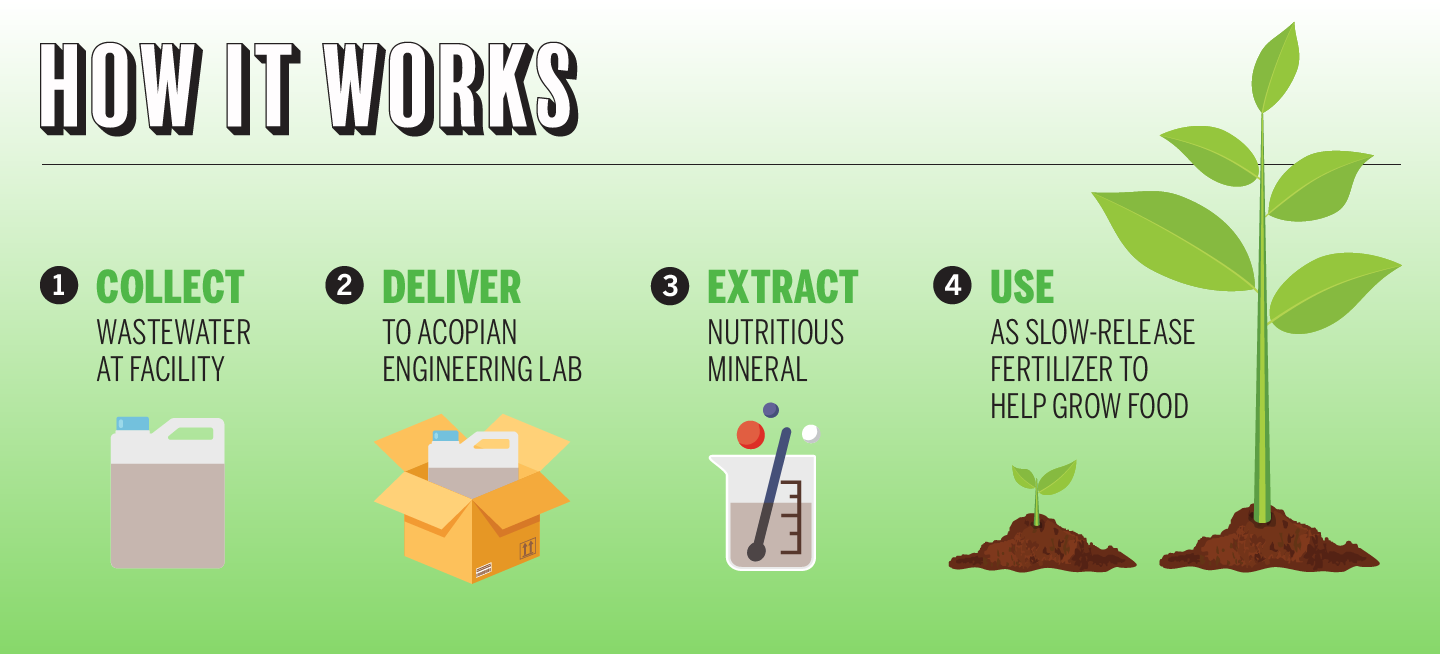Dirty Water Gets New Gig
“It’s pretty bad today,” warns Emma Leeds ’19 as she slips on a white lab coat, rubber gloves, and safety goggles and heads toward a geyser of churning wastewater. A vial of peppermint oil is passed around, dabs of it applied to upper lips to help mask the overwhelming smell.
Inside the Water Resource Recovery Center in Easton, Leeds and her student research colleagues start collecting raw sewage in several 6-liter plastic containers. Plastic tubes direct foaming liquid waste into the containers, a process that oddly resembles a growler filled at a brew pub. While certainly not the most desired destination for college students, Easton Water Resource Center is the focal point of Lafayette’s research to extract a valuable fertilizer from wastewater and rethink human waste as a beneficial renewable resource.
Although the research is still in its early stages, it has the potential to revolutionize the nation’s wastewater infrastructure, says Arthur Kney, associate professor of civil and environmental engineering.
“By reconsidering wastewater as a valuable resource rather than a costly waste product, ultimately it may become a steady, reliable, and safe source of nutrients for crops and reduce the amount of harmful discharges into river and streams,” he says.
Led by Kney and Polly Piergiovanni, professor of chemical and biomolecular engineering, students like Rachel Tenney ’18 (chemical engineering), Leeds (environmental science and Spanish), and Yue Wu ’20 (civil & environmental engineering and math) take weekly trips to the facility to collect malodorous wastewater.
It’s brought back to a lab at Acopian Engineering Center, where a chemical reaction is started by adding magnesium to the wastewater to extract a mineral similar to struvite—a magnesium ammonium phosphate crystal rich in nutritious nitrogen and phosphorous, the primary ingredients in most commercial fertilizers.
After it’s extracted from the wastewater, the mineral can be used as a slow-release fertilizer to help grow food, Kney says. Additionally, removal of more nitrogen and phosphorous, which support algae growth, also helps protect the health of the Delaware River.
“We are taking dirty water and finding use for it,” says Kney, who’s been working with his students on the project since spring 2016. “This research has the potential to help feed people in need of food and reduce pollution.”
The Lafayette project comes at a critical time as the world looks to find more sustainable ways to feed growing populations in regions with dwindling supplies of water, Tenney says.
Traditional fertilizers are harmful because they’re extremely soluble and wash away quickly. This affects oxygen levels in waterways, she says, noting that struvite is less soluble than traditional fertilizer but releases the same quantity of nutrients over time.
“We’re wasting valuable nutrients that just go out into bodies of water and negatively affect the health of ecosystems in rivers,” Leeds says. “We could be recovering it on a commercial scale to help address global dependence on fertilizer for crop yield and reduce reliance on traditional fertilizers that rely on nonrenewable resources.”
“We call it wastewater, but it’s a tremendous resource in a society that spends billions to treat wastewater and just dump it,” she says. “It’s time to rethink the wastewater industry.”
